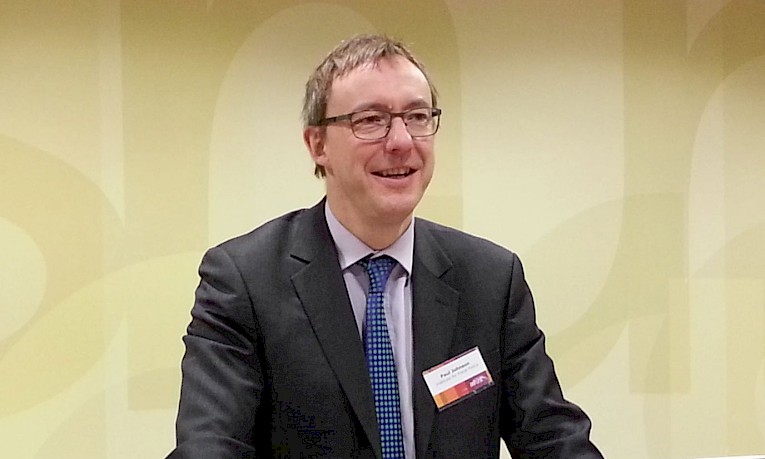The SBE had the pleasure of inviting Paul Johnson from the IFS to speak at the February evening meeting on the state of public finances in the UK, as well as a short commentary on measures of inflation. Overall Paul acknowledged that the necessary government spending cuts were underway and further cuts are in the pipeline for the UK, but challenges to the government’s fiscal position would leave a difficult task ahead.

Paul set the scene by reviewing tax increases and spending cuts of previous governments as well as the planned spending cuts which had been allocated for the next administration, noting that as many spending cuts have been planned for the next parliament as there are in total for the current parliament. Putting this into context, IMF forecasts show that this is the largest planned fiscal consolidation out of 32 advanced economies.
However, given that the same report forecast the UK to have the second largest structural deficit out of these countries in 2015, Paul believes that these cuts are overdue from the standpoint of debt management. The UK’s public sector debt currently stands at a level last seen in 1967, at 80% of national income (40 percentage points higher than it was in 2008).
Assessing the feasibility of maintaining the planned measures, Paul highlighted many obstacles the government will face in keeping spending down in the long term. He noted in particular factors such as the aging population which will mean increases in healthcare spending equivalent to almost 4% of national income (according to the most optimistic forecasts available) as well as increased spending on public sector wages to keep up with those in the private sector. Combined with the fact that the easiest spending cuts are the ones that are most likely to be enacted first, the government may have a difficult task to find room for future cuts.
Over the shorter term, Paul emphasized the existing difficulties that the government has already experienced in curbing expenditure. Real social security spending has not been cut at all but had instead flat-lined at £220 billion since 2009 due to pressures such as the Triple Lock, even with the cost reductions associated with indexing pensions by CPI instead of RPI. Departmental Expenditure Limits were reduced by 8.6% last year in real terms, but after considering that key industries such as healthcare and education are protected, there is the implication that non-protected departments will have to compensate for this by accepting harsh cuts of around 20%, severely dampening these sectors.
Given the proximity of the General Election, Paul drew attention to the fiscal rules and differences in the stated intentions of the three major parties: the Conservatives aiming for a budget surplus, Labour and the Liberal Democrats planning fewer spending cuts thus meaning a slower reduction in the UK’s debt burden.
Moving onto government revenue, Paul paid particular attention to how the composition of growth could lead to a noticeable shortfall in revenue from income tax and national insurance. In recent years, for example, employment levels have risen but lower average wages have resulted in reduced revenues to the tune of £6.5bn. The sensitivity of revenues to the distribution of growth has been exacerbated with income tax becoming more progressive and greater reliance on capital taxes.
Paul also focused on downside risks to consumers in the face of current tax plans, mainly in the form of fiscal drag with the IFS estimating a 2.8 million rise in the number of higher-rate taxpayers in 2025-2026. In addition, the freezing of thresholds for child benefits has led the IFS to forecast 1.2 million families to lose some or all of their entitlement this year. This figure is forecast to more than double by 2025-2026, suggesting that a balance must be found between maintaining the country’s debt as well as catering to the social needs of the UK.
Before concluding, Paul briefly spoke on measures of inflation used for indexing various taxes, such as the use of RPI for indirect taxes and CPI for benefits and direct taxation, along with national insurance payments which are indexed differently for employees and employers. Paul commented on the inaccuracy of RPI compared to RPIJ as well as fundamental issues with the calculation method of RPI, and he concluded that the government should be more active in phasing out the use of RPI, and that the UK statistics authority should also be more vocal on this issue. However, Paul conceded that this is likely to be a long term goal given that existing gilt contracts are linked to RPI which run to 2068.
The ONS should make progress towards using CPIH as its main measure of inflation to account for owner occupiers’ housing costs, and that factors such as council tax and the quality change in goods should also be accounted for to paint a more accurate picture of inflation. Paul also brought to light the use of a Household Index as a measure of inflation where inflation would be defined as the increase in cash outlays required to achieve the same consumption between two periods, as opposed to the current definition of an increase in prices that has been appropriately weighted. However he noted that this would not be suitable as a core measure given that under the Household Index the rate of inflation different households face diverges greatly.
Paul summarized his speech by noting that there remains a substantial budget deficit that the UK must manage. In the medium and long term there will be no easy way to achieve a budget surplus due to the increasing difficulty and reduced feasibility of spending cuts, various downside risks to government tax revenue, issues with indexation on different taxes and also the significant differences in policy of each political party.
Write up by Arjun Saini


